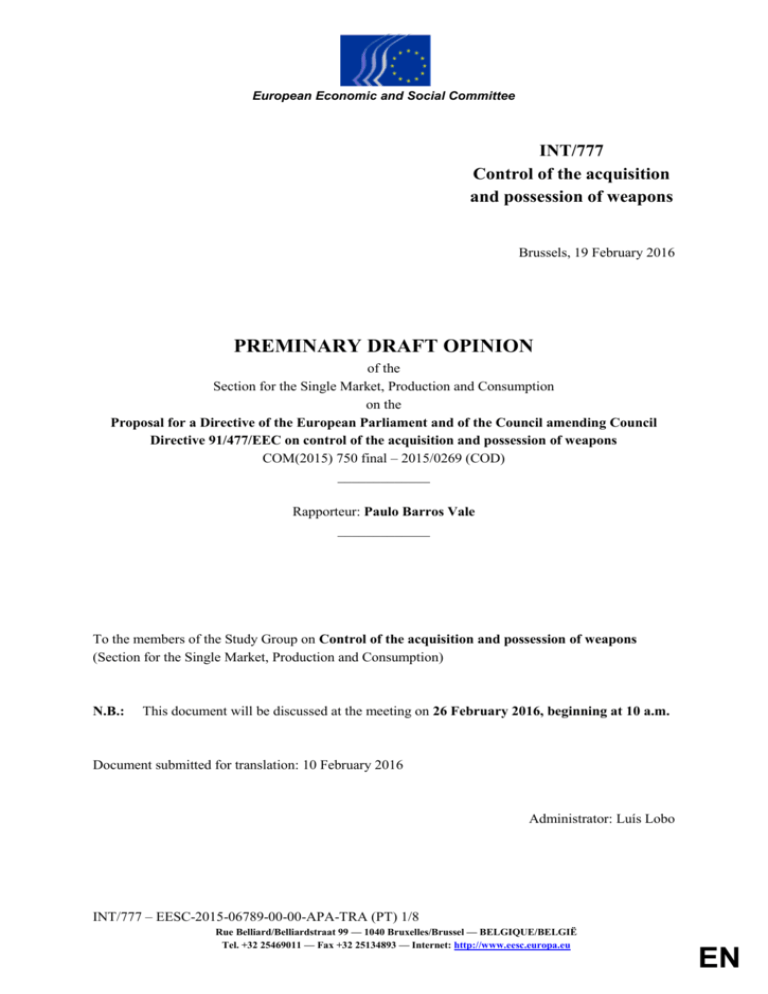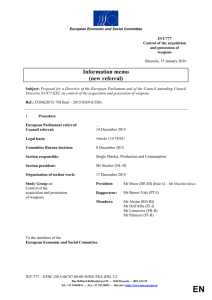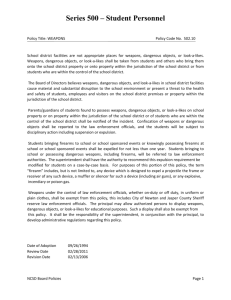Control of the acquisition and possession of weapons
advertisement

European Economic and Social Committee INT/777 Control of the acquisition and possession of weapons Brussels, 19 February 2016 PREMINARY DRAFT OPINION of the Section for the Single Market, Production and Consumption on the Proposal for a Directive of the European Parliament and of the Council amending Council Directive 91/477/EEC on control of the acquisition and possession of weapons COM(2015) 750 final – 2015/0269 (COD) _____________ Rapporteur: Paulo Barros Vale _____________ To the members of the Study Group on Control of the acquisition and possession of weapons (Section for the Single Market, Production and Consumption) N.B.: This document will be discussed at the meeting on 26 February 2016, beginning at 10 a.m. Document submitted for translation: 10 February 2016 Administrator: Luís Lobo INT/777 – EESC-2015-06789-00-00-APA-TRA (PT) 1/8 Rue Belliard/Belliardstraat 99 — 1040 Bruxelles/Brussel — BELGIQUE/BELGIË Tel. +32 25469011 — Fax +32 25134893 — Internet: http://www.eesc.europa.eu EN Study Group on Control of the acquisition and possession of weapons President: Christian Moos (DE-III) (Rule. 62 – Mindaugas Maciulevičius) Rapporteur: Paulo Barros Vale (PT-I) Members: Victor Alistar (RO-III) Gianfranco Dell'Alba (IT-I) Jacques Lemercier (FR-II) Stefano Palmieri (IT-II) Expert: Marta Moreira Costa (for the rapporteur) INT/777 – EESC-2015-06789-00-00-APA-TRA (PT) 2/8 On 14 December 2015 the Council and the European Parliament decided to consult the European Economic and Social Committee, under Article 114 of the Treaty on the Functioning of the European Union, on the Proposal for a Directive of the European Parliament and of the Council amending Council Directive 91/477/EEC on control of the acquisition and possession of weapons COM(2015) 750 final – 2015/0269 (COD). The Section for the Single Market, Production and Consumption, which was responsible for preparing the Committee's work on the subject, adopted its opinion on …. At its ... plenary session, held on … (meeting of ...), the European Economic and Social Committee adopted the following opinion by ... votes to ... with ... abstentions. * * * 1. Conclusions and recommendations 1.1 While weapons-related issues are always controversial, the recent tragic events in Europe have added even more heat to the debate. Nevertheless, the assessment of the revision of the directive must necessarily be more dispassionate and objective, analysing security and market issues in a balanced fashion and leaving the crucial question of fighting terrorism and organised crime to other discussions more suited to the gravity of these issues. 1.2 According to the UNODC Study on Firearms1, of the 875 million firearms in existence in 2007, only 3% were held by law enforcement services and 23% by the military. In an industry of this size, it is up to the legislator to identify and impose measures which are capable of mitigating the latent hazard inherent in the possession of such vast numbers of weapons. 1.3 While supporting the adoption of this directive, which clarifies definitions and introduces new requirements and more consistent rules on marking and destroying weapons, the EESC would also advocate measures that it believes would help increase public safety. 1.4 The European Union has been able to issue a great deal of legislation in many areas. A good example of this is the automotive industry, which was obliged to meet safety requirements (safety for occupants and the environment) by investing heavily in research and development. 1 United Nations Office on Drugs and Crime, Study on Firearms 2015 – A study on the transnational nature of and routes and modus operandi used in trafficking in firearms. INT/777 – EESC-2015-06789-00-00-APA-TRA (PT) 3/8 This has not been the case for the arms industry, where the rules have fallen short of what could have been achieved in terms of security and the tracking of weapons and people involved in criminal acts. We must therefore be firm on the objectives to be achieved in an area as sensitive as security. 1.5 Since not only weapons traceability but also ammunition traceability is important, the EESC believes that the industry should be encouraged to start placing indelible marks on bullets, somewhere the marks cannot be destroyed upon use. If the authorities were to make such data available on interoperable databases, it would contribute greatly to improving the efficiency of investigations. 1.6 The EESC argues that Europe could follow the example of the Australian and UK buyback programmes, which would take thousands of weapons out of circulation. While there is no proven direct link between the number of weapons in circulation and the number of offences committed, it is statistically probable that fewer crimes and accidents would occur, and even that fewer guns would fall into the hands of criminals. 1.7 The technological development of 3D printing constitutes a danger since it can be used to manufacture weapons that are just as lethal as those made by conventional methods, but impossible to control or track. Furthermore, since these weapons are mostly made of plastic, traditional security systems cannot detect them. This issue urgently needs to be put on national security agendas so that concerted preventive measures can be taken against the uncontrolled proliferation of lethal weapons. 2. Background 2.1 Amidst acute security concerns, the Commission has published a proposal to amend Council Directive 91/477/EEC2, as amended by Directive 2008/51/EC3, on control of the acquisition and possession of weapons. 2.2 This review is being undertaken in the context of the European Agenda on Security, adopted on 28 April 2015, which seeks to ensure an effective and coordinated response at European level to security threats. The European Agenda on Security has identified differences between countries' legislation as being an obstacle to effective controls and cooperation between national police forces, and has called for a review of legislation on firearms and of the rules on deactivation. 2.3 The objective of the directive is to guarantee public safety and facilitate the functioning of the internal market by establishing the rules to adopt for all stages of a firearm's life cycle, from production to destruction. 2 3 Council Directive 91/477/EEC, OJ L 256, 13.9.1991, p. 51; EESC opinion: OJ C 35, 8.2.1988, p. 25. Council Directive 2008/51/EC, OJ L 179, 8.7.2008, p. 5-11; EESC opinion: OJ C 318, 23.12.2006, p. 83. INT/777 – EESC-2015-06789-00-00-APA-TRA (PT) 4/8 2.4 The directive establishes the minimum requirements that each Member State should impose as regards the acquisition and possession of the different categories of firearms, including those used for hunting and shooting sports. 2.5 As a basis for the review of the current legal framework, three evaluations were carried out on the legislation currently in force, which identified a need to adopt EU-wide minimum rules on illicit firearms trafficking and to revise the directive in force in order to: harmonise the rules for the marking of firearms; adopt common standards and procedures and introduce registration requirements for deactivated firearms; establish procedures for the convertibility of alarm/signal weapons and replicas; promote the exchange of knowledge between Member States and develop and maintain databases on the manufacture, possession and deactivation of weapons; and define a common approach to the classification of hunting and sporting firearms. 2.6 Stakeholders' views were taken into account. Member States and NGOs agreed that the proposed directive would help to prevent the diversion of firearms to the illegal market. However, private sector representatives were concerned by amendments to the categories of firearms and the impact thereof on small and medium-sized firms. 2.7 All stakeholders believed that the reactivation of deactivated weapons was a relevant source of weapons for criminal use and considered the harmonisation of rules against this practice to be a priority. 2.8 All the stakeholders saw a need for information exchange between Member States, the harmonisation of definitions, and the establishment of minimum standards for deactivation guidelines. 3. General comments 3.1 Recent tragic events have precipitated the debate on the sale and use of weapons. Public safety is increasingly under threat from terrorism and there is a pressing need to take decisive action to counter the ease with which people can get hold of firearms, which continue to fall into the hands of radical groups, criminal organisations and disturbed individuals whose motives are incomprehensible, who then use these firearms to perpetrate barbaric crimes. 3.2 Nor can we ignore the firearm-related fatalities and serious casualties resulting every year from the mishandling or unsafe storage of weapons. 3.3 The EESC welcomes the clarifications currently being proposed since they make a significant improvement to the directive being amended. INT/777 – EESC-2015-06789-00-00-APA-TRA (PT) 5/8 3.4 Nevertheless, the EESC believes that, in view of the ongoing security concerns, legislation on this issue needs to be more ambitious. The Commission should not simply draft legislation as an immediate response to recent acts of terrorism, but when doing so should also seek to resolve safety issues relating to legal firearms. 3.5 According to the UNODC Study on Firearms published in 2015, 74% of the 875 million firearms in the world in 2007 were possessed by civilians. Legally obtained weapons have also been used to commit over 63 000 homicides in the European Union over the last 10 years4. There are EU countries where over 40% of crimes involve the use of a weapon, and in most EU Member States this figure stands at over 20%. These figures do not include suicides or accidents. 3.6 Australia provides an excellent example of weapons control. Following an incident where a man entered a cafe and killed 35 people and wounded 23 others with two weapons, Australia embarked upon one of the most substantial overhauls on record of its laws on the use and possession of weapons. This led to a visible reduction in firearm-related deaths. It banned certain types of weapons, introduced a requirement to provide a genuine reason for possessing a weapon (which could not be purely for self-defence) and financed a national buyback programme. This initiative led to the surrender of 700 000 weapons and a drastic fall in firearm-related homicides. 3.7 The reasoning behind the buyback programme was that the availability of weapons enabled people to act on homicidal impulses and commit mass murder. 3.8 Like Australia, following random shootings which resulted in 15 fatalities and a further 15 wounded, the United Kingdom also banned the use of certain types of weapons, introduced mandatory registration for owners and funded a buyback programme. Although the outcomes were not as visible as in Australia, these measures likewise led to a fall in firearm-related crimes. 3.9 The EESC believes that these examples should be followed in the rules for obtaining a licence to use and carry a weapon, in the ban on certain types of weapons and even in programmes set up by Member States to buy back weapons in order to destroy them. 4. Specific comments 4.1 This initiative shows due regard for the principles of subsidiarity and proportionality. A directive is the appropriate instrument to use here, since there is no other way to amend the rules in force. 4 Homicide Counts and Rates (2000-2013) – UNODC (United Nations Office on Drugs and Crime). INT/777 – EESC-2015-06789-00-00-APA-TRA (PT) 6/8 4.2 The EESC welcomes this directive's amendments to a number of articles in the previous directive; they lend clarity and introduce new requirements that significantly improve the previous rules. 4.3 The EESC supports the introduction of compulsory medical tests for issuing or renewing licences to use and carry a weapon - a practice which many Member States have already adopted. However, it would point out that the directive could also require medical fitness tests to determine a person's ability to handle firearms as well as the frequency of training needed on the storage and transportation of weapons and their components. 4.4 The concept of marking weapons and components is also being extended. The EESC suggests going a bit further with respect to marking bullets by requiring the industry to place an indelible mark somewhere that it cannot be destroyed upon use, such as inside ammunition, in order to ensure full traceability. Since it is normally bullet casings and not weapons that are left behind at crime scenes, marking of this type could be a valuable source of information in police investigations. 4.5 With regard to databases on firearms, the EESC supports the new wording, which extends the scope of records on firearms to include the destruction of these arms. This contributes added value and is an important tool for control and investigation purposes. The Commission should provide the authorities with support to ensure real-time access to these registers in all Member States, facilitating and enabling the quick, efficient exchange of information in order to identify and locate firearms. 4.6 Category A – prohibited firearms – will now include deactivated semi-automatic firearms, which were previously classified as subject to authorisation. The EESC recognises how dangerous these weapons are, but argues that the focus should be on the rules concerning their conversion, by publishing technical standards for deactivating and destroying weapons, which ensure without any doubt that the process cannot be reversed. 4.7 Semi-automatic firearms for civilian use which "resemble weapons with automatic mechanisms" are also classified as prohibited. The term "resemble" is not sufficiently objective since clear criteria must first be established as to what types of "resemblance" would warrant these weapons being classified as prohibited firearms. 4.8 Alarm and signal weapons, salute and acoustic weapons as well as replicas are now to be classified under Category C as subject to declaration. Although this is already the case under the laws of some countries, the EESC is not sure that it is appropriate since, in addition to the fact that the UN Protocol does not classify them as firearms, in those countries whose legislation does not yet make it mandatory to declare them, this will entail significant administrative costs for a type of weapon that does not seem to present a particularly significant public safety risk. INT/777 – EESC-2015-06789-00-00-APA-TRA (PT) 7/8 4.9 The public safety risks presented by these and other weapons, such as air guns, should be assessed in a study on the hazards they entail and the possibilities of converting them into more lethal weapons. This study could serve as a basis for new rules on the safety, conversion, deactivation and destruction of weapons. 4.10 In a digital society it is important to consider the danger presented by online weapons trading. Facebook and Instagram have announced restrictions on the sale of weapons on their social networks, banning their users from advertising or dealing in weapons through posts, discussion groups or private messages. The EESC believes that, despite the fact that it is possible for dealers and brokers to be allowed to trade in certain weapons online, only faceto-face transactions should be authorised in order to ensure strict control by the relevant authorities. 4.11 Technological innovation has brought with it the advent of 3D printers. Weapons have not been excluded from this technology and instructions and programmes for printing lethal weapons soon appeared on the internet. In the absence to date of legislation to regulate the printing of weapons, this technology constitutes a real threat which has yet to be given the importance it deserves. Nations must come together to discuss this issue, monitor the network and even control the acquisition of materials used to produce these types of weapons. _____________ INT/777 – EESC-2015-06789-00-00-APA-TRA (PT) 8/8






